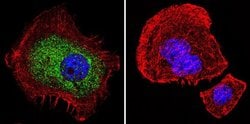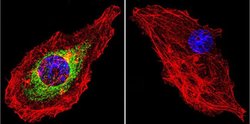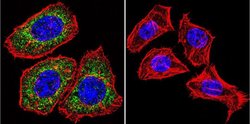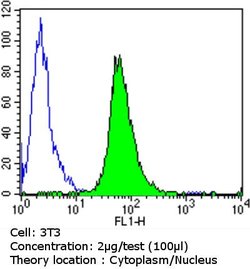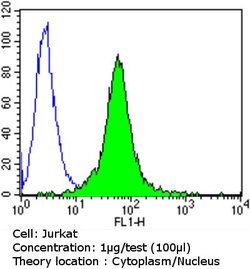Learn More
Invitrogen™ Glucocorticoid Receptor Monoclonal Antibody (BuGR2)


Mouse Monoclonal Antibody
Supplier: Invitrogen™ MA1510
Description
MA1-510 detects glucocorticoid receptor (GR) from human, mouse, rat, guinea pig, rabbit, sheep and yeast samples. This antibody does not react with primate, avian or amphibian GR. MA1-510 has been successfully used in Western blot, immunofluorescence, immunocytochemistry, flow cytometry, immunohistochemistry, immunoprecipitation, and gel shift procedures. By Western blot, this antibody detects a 97 kDa protein representing GR in L929 cell extract. Immunocytochemical staining of GR in L929 cells with MA1-510 results in staining of both the cytoplasm and nucleus, even in the presence of hormone. Using enzymatic digestion analysis, MA1-510 reacts with the undigested 97 kDa GR, a 17 kDa DNA-binding trypsin fragment, and a 45 kDa steroid- and DNA-binding chymotrypsin fragment. The MA1-510 immunogen is partially purified rat GR. Reconstitute with 100 μL distilled water.
Glucocorticoid Receptor (NR3C1) is a receptor for glucocorticoids that can act as both a transcription factor and as a regulator of other transcription factors. Glucocorticoid Receptor can also be found in heteromeric cytoplasmic complexes along with heat shock factors and immunophilins. The protein is typically found in the cytoplasm until it binds a ligand, which induces transport into the nucleus. Glucocorticoid Receptor is expressed in the heart, detected in left and right atria, left and right ventricles, aorta, apex, intraventricular septum, and atrioventricular node as well as whole adult and fetal heart. Alternate splicing, the use of at least three different promoters, and alternate translation initiation sites result in several transcript variants encoding the same protein or different isoforms, but the full-length nature of some variants has not been determined. Mutations in the Glucocorticoid Receptor gene are a cause of glucocorticoid resistance, or cortisol, resistance. Studies have shown that glucocorticoid receptor (GR) must be associated with a complex of chaperone proteins for ligand activation. GR binds to known steroids such as dexamethasone with nanomolar affinity.
Specifications
| Glucocorticoid Receptor | |
| Monoclonal | |
| 1 mg/mL | |
| PBS with 0.05% sodium azide; pH 7.2 | |
| P04150, P06536, P06537, P35547, P49115, P59667 | |
| Nr3c1 | |
| Partially purified rat GR. | |
| 100 μg | |
| Primary | |
| Human, Mouse, Rat, Rabbit, Sheep, Yeast, Guinea Pig | |
| Antibody | |
| IgG2a |
| Flow Cytometry, Gel Shift, Immunohistochemistry (Paraffin), Immunohistochemistry (PFA fixed), Immunoprecipitation, Western Blot, Immunocytochemistry | |
| BuGR2 | |
| Unconjugated | |
| Nr3c1 | |
| cytosolic/nuclear receptor; fb13f09; GCCR; Gcr; GCRST; glucocorticoid nuclear receptor variant 1; glucocorticoid receptor; glucocorticoid receptor 1; glucocorticoid receptor alpha; GR; gr alpha; GR Kit; Grl; Grl1; Grl-1; Nr3c1; Nuclear receptor subfamily 3 group C member 1; nuclear receptor subfamily 3, group C, member 1; nuclear receptor subfamily 3, group C, member 1 (glucocorticoid receptor); OTTHUMP00000222854; OTTHUMP00000222858; utouto; utut; wu:fb13f09; zgc:113038 | |
| Mouse | |
| Protein A | |
| RUO | |
| 100008890, 100135583, 14815, 24413, 2908, 443412 | |
| -20°C, Avoid Freeze/Thaw Cycles | |
| Lyophilized |
Your input is important to us. Please complete this form to provide feedback related to the content on this product.
